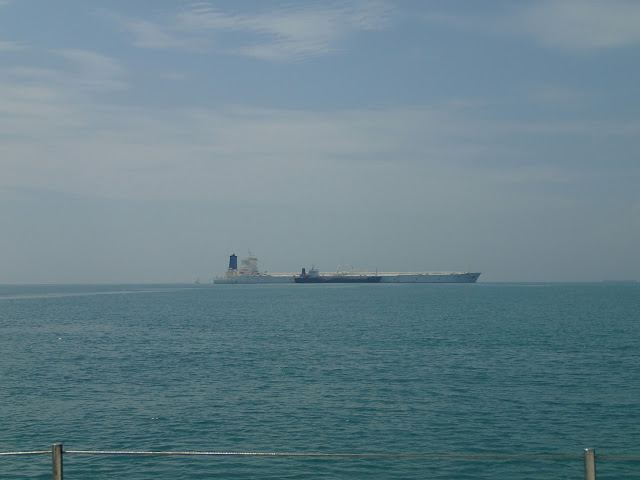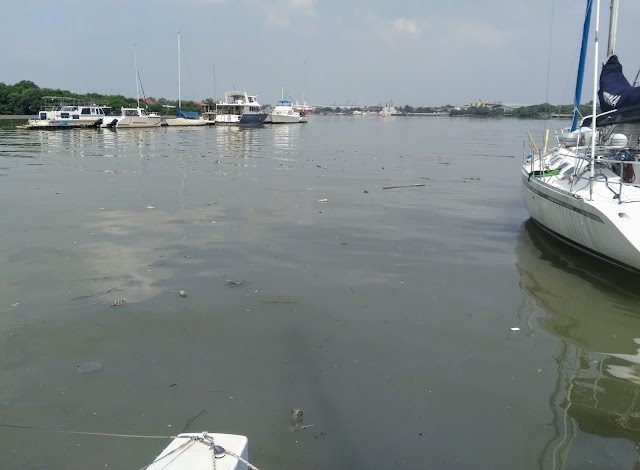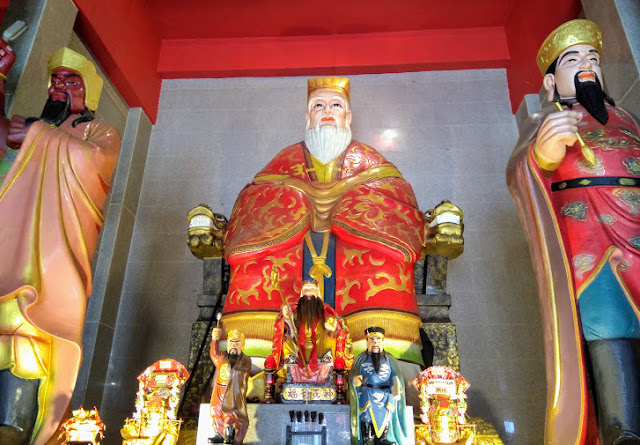Shortly after lunch
we reached Port Dickson and dropped anchor close to Admiral Marina
near the beach. It was a lovely calm spot.
Most of the boats
had booked berths in the marina and when we dinghied in we saw they
were crowded together in hot pens without much breeze. Thank
goodness for the shady big pool at Admiral Marina and we lost no time
in cooling off.
Many boats stayed on
at Admiral Marina to go on a tour to Kuala Lumpur but Robert had made
contact with an agent for the faulty radar and we wanted to get
closer to Kuala Lumpur to deliver it. Port Klang has a marina and
easy access to Kuala Lumpur so it seemed a good plan.
We set off early in
the morning and initially the current was with us but it soon turned
and we had current against us the rest of the way. As soon as we got
closer to Port Klang the area became very busy with big ships. It is
the main port of Malaysia and the 11th largest port in the
world. Non-stop action with loading and unloading 24/7 at 3 different
ports within the muddy delta.
We crossed the busy
Port Klang shipping lane and anchored in a calm mangrove lined
channel just off the shipping lane. There was a very strong current
through the channel but it was peaceful and if not for the big ships
passing in the distance it would have seemed remote.
Robert had worked
out tides and currents and the next morning we left at what we
thought was the optimum time to our advantage. But the current seemed
to be a bit against us so we slowly trundled past the long South Port
and its line of ships and cranes, grateful that we had a gap without
a big ship heading our way.
We motored further
up the wide river and eventually found Royal Selangor Yacht Club. We
had considered leaving Pegasos at RSYC for about 5 months until our
return next year but we immediately noticed the vast amount of
rubbish moving downstream. Much of the rubbish collects between the
boats and the jetties resulting in smelly piles of refuse jammed
between the boats and the jetties.
In addition to the
endless stream of rubbish moving back and forth with the tides, RSYC
has a channel between its mooring jetties which is used by big
trawlers, smaller fishing boats, power boats and just about every
other speeding craft which sends big wakes crashing against the boats
tied to the jetties. We quickly decided this wasn’t a good place
to leave Pegasos.
The advantage of
RSYC is their big swimming pool and even bigger restaurant with an
extensive menu.
Robert made further
contact with the agent for the faulty radar and much to our surprise
one of their guys came to collect it from us at the marina saving us
a trip into Kuala Lumpur. Their technician is away for a couple of
weeks so we wait and see what transpires – repair or replace as it
is still under warranty.
We were keen to get
out of Port Klang as quickly as possible but the complex tidal system
in the delta meant that we could only leave in the afternoon. And so
we set off under a black cloud – which is often the case in the
afternoons as it rains daily. We hadn’t got far when the
thunderstorm broke and it started raining heavily, probably the
heaviest rain we’ve had so far. Visibility was very poor and we’re
in a busy shipping channel. We kept the spray dodger down to see
better but we got horribly drenched in the cockpit. We got as far as
the North Port loading docks and decided we had enough so we moved
over to the edge of the channel where it is too shallow for any big ships
and dropped the anchor next to mangroves. Robert closed up the tent
covers and I had a warm shower and it turned out to be a peaceful
anchorage although it rained for hours.
We caught the
morning tide early and set off with the current, motoring along at
over 7 knots for the first few hours. We passed a bizarre sight of
hundreds of people standing in the ocean – what it turned out to be
is a sandbank in the strait which dries out at certain high tides and
lots of little boats ferrying people from the shore to the sandbank
to experience the phenomenon of “standing on the sea” with boats
passing around.
The whole area is
very busy with trawlers and smaller fishing boats. Some of the
trawlers had AIS but many did not and so it was a constant look out,
especially for nets strung out from the smaller fishing boats. The
trawlers move under 3 knots when they drag their nets but can move
exceptionally fast when heading out to sea. We saw a trawler coming
closer from slightly behind our starboard side heading towards us. We
kept an eye on it and got worried when it didn’t change direction
and was moving much faster than us. Through binoculars I could see no
one above deck! In the end we did a full 360 deg turn to avoid being
hit by the trawler. At the last moment a few heads popped up on it
looking surprised. They clearly hadn’t seen us. One of the other
rally boats was not so lucky in the same area and got hit by a
trawler in the front with enough damage to its crossbeam
and its mast fell over.
We also received
several SART alerts on our AIS which is a signal from a Search and
Rescue Transponder intended for emergency use at sea and is used to
locate a vessel in distress. Normally closest boats would respond to
save lives. However these alerts were originating from close to the
shoreline and we had read that the local fishermen in this area use
these transponders to locate their fishing nets! Insane behaviour.
It’s a wonder that the Malaysian authorities don’t do anything to
stop it.
By lunchtime we no
longer had the current with us and the wind was in the front so the
afternoon was a bumpy and swelly ride. Very tedious 11 hours to cover
62 miles. Entering the river mouth of Sungai Bernam is a bit tricky
as it is extremely shallow in places. We crept along watching the
depth and two trawlers overtook us, clearly following their
waypoints. Good enough for us so we sat behind one of the trawlers
following it. We moved off to the side of the wide mouth and anchored
in only 1 metre! We had heard lots of stories about fishing boats
crashing into anchored yachts in this area so we put on all the nav
lights, dangled a flashing light and kept an inside light on.
Nothing hit us
during the night and the next morning we set off for our most
northerly anchorage in this leg – Pangkor Marina. It was a pleasant
motor sail dodging a few trawlers along the way. The marina was fully
booked with rally boats so we joined a few anchored on the outside of
the marina. Luckily we have a shallow draft so we anchored as close
as possible and ended up just outside the entrance within paddling
distance of the bar – convenient! A catamaran tried the same area
but it was too shallow for them and they backed off. As Robert later
told them it’s a trimaran puddle.
The marina arranged
a tour to Pangkor Island for the rally participants. We all crossed
the gap by ferry and piled into pink taxis.
As well as Fu Lin
Kong Temple, a decorative Taoist temple built over a 100 years ago
with lovely gardens and ponds with terrapins.
Less appealing was a
visit to a factory outlet that makes the fishy smelling dry snacks so
beloved by Malaysians.
Lunch was the
highlight in an exquisite beach setting in Nipah Bay. Tables and
chairs were set up under large shady trees and a great lunch was
served by Nipah Deli.
We swam after lunch in the very warm calm water. We could have stayed
there for days and earmarked the bay as an anchorage for next year.
Lots of beers were provided for the thirsty crowd.
Lots of beers were provided for the thirsty crowd.
The next day we had
to clear in at Immigration, Port Authority and Customs – as usual all 3 are not in the same street, not even in the same district and we
had to hire a scooter and buzz around from one to the other filling
in forms and having bits of papers stamped. Although we checked into
Malaysia at Puteri Harbour, all ports in Malaysia have check in/check
out requirements for boats – a pain in the rear but at least the
paperwork is processed with far less hassle than in Indonesia and the
various offices made their own photocopies.
We found Aeon
shopping centre, the big attraction as always being the aircon. We
stocked up on a few provisions but mainly enjoyed the aircon and food
court. On one of our scooter outings, we found a buddhist temple -
Tua Pek Kong Temple in the nearby Manjung district. It started off
about 100 years ago but has seen much more recent construction and
now covers a wide area. The statues are absolutely enormous!
Giant size statues compared to me standing in the foreground.
Giant size statues compared to me standing in the foreground.
We treated ourselves to a 3 day tour of the Cameron Highlands staying at a 4
star hotel. The luxury bus, accommodation and guide was arranged by
the Sail Malaysia organisors, the cost for ourselves. A bit pricey
but an opportunity that we probably wouldn’t do again and a nice
way to end off this leg of our furthermost north sail to date. 22 of
us set off on a long windy road heading inland and upwards.
The Cameron
Highlands is a high mountainous area first surveyed by the British
geologist William Cameron in 1885. It was further developed in the
1930’s as people saw the opportunity to escape from the heat as the
Cameron Highlands is high enough for a cool climate. In fact for the
first time in many months we wore long sleeves and coats! The area
is famous for its tea estates and farmlands and very scenic
countryside.
Our guide took us on
tours of tea estates, strawberry farms, flower gardens, butterfly
park, “honey farm” (yes it’s really just hives) and a
waterfall.
The scenery was spectacular, beautiful cultivated hillsides and mist swirling around mountain tops in the morning.
It’s also crowded with tourists and some of the attractions felt rather contrived. In some places the ratio of vendors to product was overwhelming, everyone selling the same tourist tat (made in China). The fresh fruit and vegetable markets were of excellent quality and we came back with bags of fresh produce.
Big Rajah Brooke butterflies
The scenery was spectacular, beautiful cultivated hillsides and mist swirling around mountain tops in the morning.
It’s also crowded with tourists and some of the attractions felt rather contrived. In some places the ratio of vendors to product was overwhelming, everyone selling the same tourist tat (made in China). The fresh fruit and vegetable markets were of excellent quality and we came back with bags of fresh produce.
Big Rajah Brooke butterflies
What to do with your old wellies
Blue orchids
Slipper orchids
All in all the Cameron Highlands was a great experience, interesting and fun with our fellow travellers.
On our return to Pangkor we were happy to see Pegasos hadn't moved in our 3 day absence. We had decided to leave Pegasos at Admiral Marina in Port Dickson while we go home to SA so we needed to go back south again taking a few days to get there.
When we got to Port Klang and contacted the radar agent, we learned that the Australian B&G agent would send a replacement at our cost for freight and duties! And not only that, we have to pay the freight return costs for the faulty radar too! What a cheek to pay international freight costs for something which will be discarded anyway. This is actually the second faulty radar from B&G the first one was faulty on arrival and we paid the return costs at the time. Not a satisfactory outcome for a radar that worked for only a few days but B&G have us by the short and curlies.
We carried on back south until we reached Port Dickson and anchored off the beach near the town. We had to do the usual clearing in at Immigration, Customs and Port Authority. A young man was the only official at Port Authority and at the end of our form filling and stamping session he said the cost is MYR50. For what we asked. He hedged and mumbled something about port charges. We dug our heels in. He got irritated at our refusal to pay unless the reason was clearly stated and waved us off with some comments. He's not good with extortion.
The next day we motored into Admiral Marina and tied up. This will be Pegasos' home for the next 5 months while we fly back to SA for summer.
We've come a long way on this trip: 1600 Nautical Miles from Lombok, Indonesia to Port Dickson, Malaysia.
When we got to Port Klang and contacted the radar agent, we learned that the Australian B&G agent would send a replacement at our cost for freight and duties! And not only that, we have to pay the freight return costs for the faulty radar too! What a cheek to pay international freight costs for something which will be discarded anyway. This is actually the second faulty radar from B&G the first one was faulty on arrival and we paid the return costs at the time. Not a satisfactory outcome for a radar that worked for only a few days but B&G have us by the short and curlies.
We carried on back south until we reached Port Dickson and anchored off the beach near the town. We had to do the usual clearing in at Immigration, Customs and Port Authority. A young man was the only official at Port Authority and at the end of our form filling and stamping session he said the cost is MYR50. For what we asked. He hedged and mumbled something about port charges. We dug our heels in. He got irritated at our refusal to pay unless the reason was clearly stated and waved us off with some comments. He's not good with extortion.
The next day we motored into Admiral Marina and tied up. This will be Pegasos' home for the next 5 months while we fly back to SA for summer.
We've come a long way on this trip: 1600 Nautical Miles from Lombok, Indonesia to Port Dickson, Malaysia.
It's been a jam-packed busy trip - the highlight was definitely the orangutan tour in Borneo but there were many other great times especially with the rally crowd. Next year we hope to sail the east coast of Malaysia at our own pace with Pegasos. Have a good rest Pegasos, see you in May 2020.
















































































